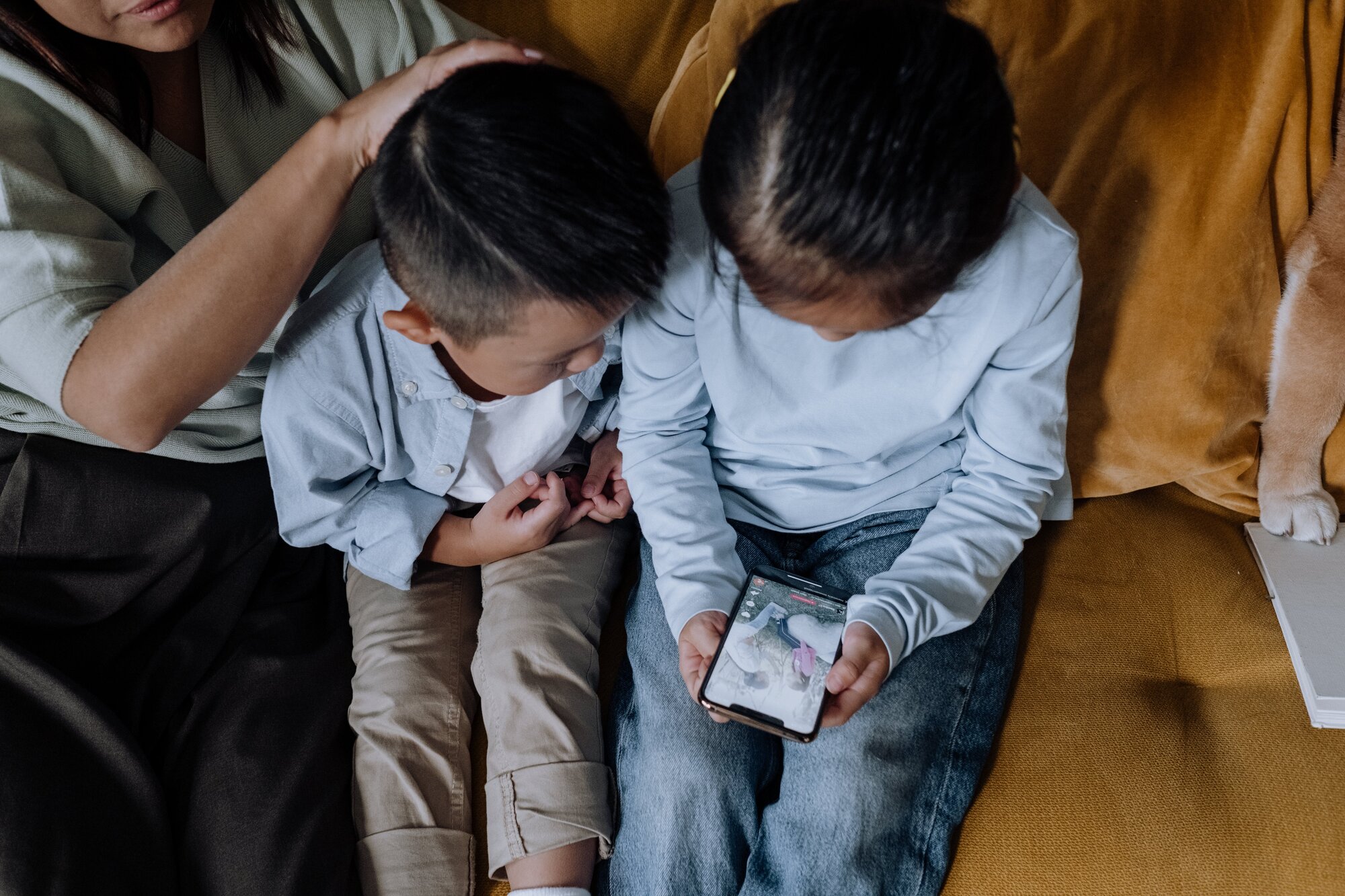FREE STANDARD SHIPPING, ALWAYS

Family Digital Cleanse: Managing Screen Time and Technology Use
Not sure how to digitally detox your household? Read on for tips on parenting in the digital age.
Posted 2/1/2024

Family
Screens are everywhere, and they’re one of the biggest challenges of parenting in the digital age. From handing your phones to your toddler while grocery shopping (so they don’t scream or toss extra cans of Beefaroni in your cart when your back is turned) to long road trips, screen time is becoming a norm for both parents and kids.
And while everyone loves a good dog TikTok here and there, there can be a pretty addictive side to social media (which you know all too well if you have found yourself in the wee hours of the morning watching try-on hauls or ASMR videos). Screen time can be a huge drain on our time and attention. Devices can distract us, damage our health, interfere with our sleep, and, most concerning for families, hinder real social interactions.
Have you noticed any of these negative results stemming from your family’s tech habits? If you have, screen time management is probably the answer you’re looking for. And while you can do a lot by limiting screen time for yourself and your children, some families may feel the need to take a bigger step. One solution that’s growing in popularity is a digital detox for families. This is when your entire family unplugs and spends some much-needed tech-free family time together. If this sounds like just the thing your family needs, read on to learn what a digital detox is all about.
The Challenges of Parenting in a Digital World
Parenting in the age of digital technology has its pros and cons. After all, not all screen time is bad for your kids, and turning on an episode of Octonauts can entertain them while giving you some much-needed breathing room. At the same time, uncontrolled use of digital devices can be very harmful to impressionable young minds. Let’s look at some of the positive and negative ways both parents and kids can use devices.
Healthy Screen Time
Kids can learn fascinating facts about the world we live in that they’d never be exposed to if it weren’t for digital devices. There are also countless apps out there that make learning easier and a whole lot more fun, contributing positively to your kids’ education.
Not all screen time is the same. When children watch longer programs or do focused tasks in front of screens, they’re able to pay attention for longer. Studies have suggested that using ebooks and learn-to-read apps can improve reading skills and creative thinking in young users. When screens are used with parental involvement, these co-viewing activities can also enhance language learning in young children.
Unhealthy Screen Time
Since TV, phone, tablet, and computer screens are all around us these days, a lot of research has been completed to uncover the effects of screen time on children and adolescents. And many of the results aren’t pretty.
Viewing screens for more than an hour each day has been linked with many social, emotional, and health issues. These include a higher risk of obesity, as well as getting less (and poorer quality) sleep. Screen-using children have been found to have increased chances of behavior and emotional regulation problems, speech delays, lower academic performance, and poorer social interactions with family and peers. As if that weren’t enough, there are also safety issues to consider, as children are at risk of exposure to inappropriate material or even unwanted contact from adults.
Parental Screen Time
In case you thought it was only your kids’ screen time you needed to manage, there are many indications that parental screen time is also quite detrimental to families with kids. Adult screen time can make parents have an absent presence in their children’s lives. When their parents are distracted by their screens, children have fewer quality chances to interact and bond with them, and this can affect their ability to form relationships in the future. For all these reasons, we should look for ways to limit technology use in family life.
Solutions for Managing Screen Time
There are several ways to help you manage screen time in your family. Some are very simple and easy, while others require a bit of technical know-how. A few are going to require serious changes.
There are plenty of parental control apps out there that help you to limit the time your children use their screens and also what they use them for. Apps like Net Nanny can limit screen time, block apps on their devices, and even provide web filtering. If your children are old enough to understand, you can set firm screen time rules by simply having them hand over their devices or turn off screens to improve their digital health.
You can also manage how your family sends messages by encouraging them to use a family messaging app like HeyFam, and create a room that’s sole purpose is to act as a safe space to ask questions, set guidelines and talk honestly about issues like screen time —without getting lost in a group thread about cello practice or grocery requests.
There are also healthy digital options, like using your screens to create a family photo books together. Spend a few minutes each month picking out the pics you and the kids want to print in your monthly subscription. Take turns picking the cover photo, adding captions and other details you’ll want to remember. This is a great opportunity to not only spend time as a family, but to bond over shared experiences.
Screen time guidelines differ, but most experts agree that children under 24 months should have only limited exposure to screens and co-watch with a caregiver rather than being left alone. Children aged two to five years old should not exceed one hour a day, and older children’s screen time should be monitored.
If these screen time management methods aren’t working for your family, it might be time to try something more intensive. If toys are abandoned in favor of screens and your kids have fits when their screens are taken away, these are good signs that a total digital detox can be helpful for the family. This means a period of time — a full weekend, for example — where you completely cut out non-emergency screen activities.
Does that sound intimidating? Probably, but here are some steps to follow to help improve your chances of success.

How to Execute a Digital Detox
If you’re going to try a digital detox, these are some good steps to follow to help things go smoothly.
1. Talk about it. If the idea comes from only one side, it may be seen as a tyrannical rather than a well-intentioned move to help the family. That’s why talking about it with your partner and children, if they’re old enough to understand, is crucial. Your kids might not like the idea, but they should at least understand that it’s being done for their own good and for the good of the family.
2. Decide together. For your first digital detox, try to outline the rules together. If your children have some input, they’ll be much more likely to go along peacefully with the detox. You can work out what’s allowed and what isn’t, as well as when the detox will begin and end. These rules also have to be fair for everyone to respect them. If you’re cheating by using your phone after the kids have been put to bed, they’ll very likely figure it out!
3. Get unplugged. Plan out how you’ll go through with your detox in advance. Some families will just unplug their TVs and put their phones in a box. Others will lock all their devices in a storage closet except for one phone that can be used for emergencies. It’s also advisable to let your friends and relatives know when you’re going into a detox. This will hopefully get you some support, and they also won’t worry that you’re not following your normal online patterns.
Of course, have plenty of activities planned to replace the things you normally do in front of your screens. Don’t just think of the kids; adults need to have other interesting things to do as well! While you may remember what it was like in the “good ol’ days,” your kids are digital natives. They’ve experienced the magic of screens their whole lives and may not have any idea how to entertain themselves without them.
Once you’re ready, execute your plan and do some family bonding without screens to improve your digital health.
What to Do Instead
There are plenty of tech-free parenting tips available online to give you ideas — ironic because you’ll have to use your screens to find them before your detox! With younger children, try to focus on physical activities and those that give you lots of valuable parent-child interaction. Older kids and adolescents might prefer self-led activities. And for parents, relaxing self-care activities might be just the thing. Here are some ideas to start you on your detox journey.
- Reminisce while looking through family photo book
- Go to the zoo
- Cook together
- Have a family picnic
- Reorganize the house
- Play sports
- Do a family art project
- Go on a hike or a nature trip
- Take a road trip and play car games on the way
- Read books together
- Play physical games, cards, or board games
- Get crafty
- Build a fort
- Visit your relatives
Digital Detox for Stronger Families
These days, kids and technology go hand-in-hand. However, giving your children a break from their devices can really do a world of good. Managing screen time with a family digital detox can help promote social skills, language, academic abilities, overall health, and family cohesion. It can also help promote healthier digital habits once screens are inevitably allowed back into your lives.
Readers are loving

95 Best Yearbook Quotes

32 Happy Anniversary Messages That Will Make You Fall in Love All Over Again

How Much to Tip a Wedding Photographer